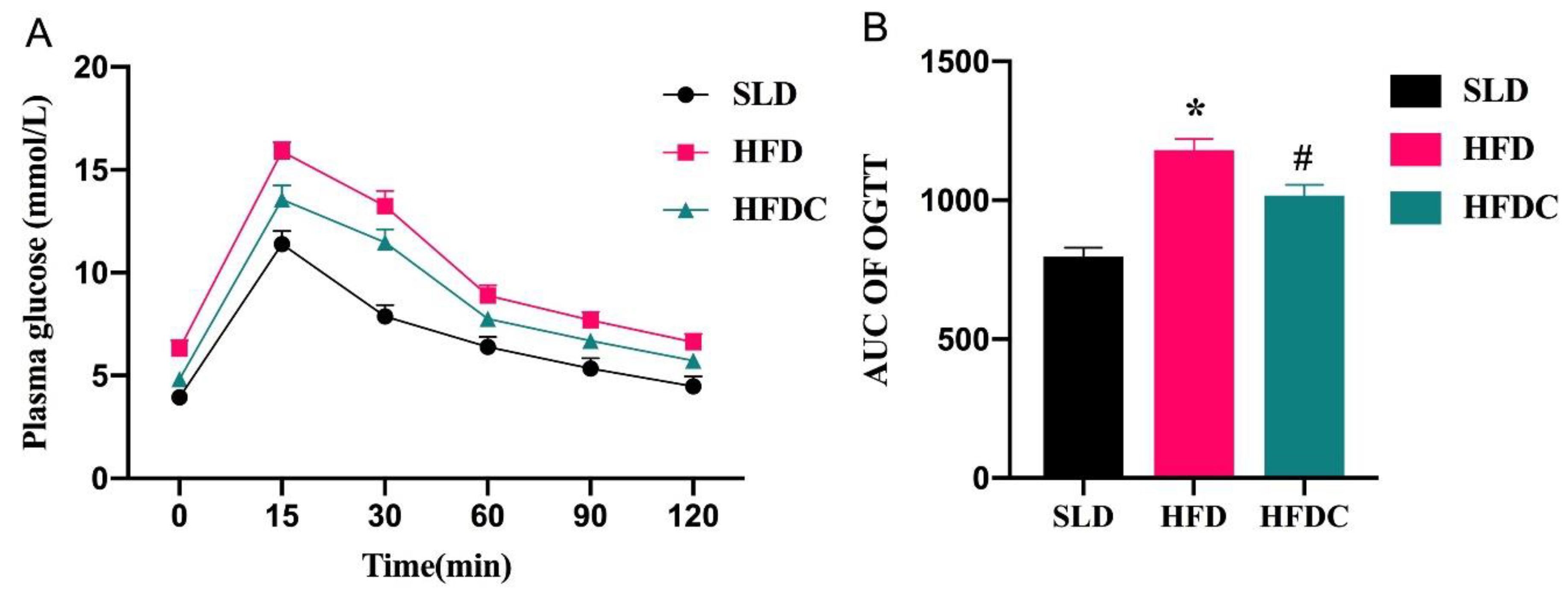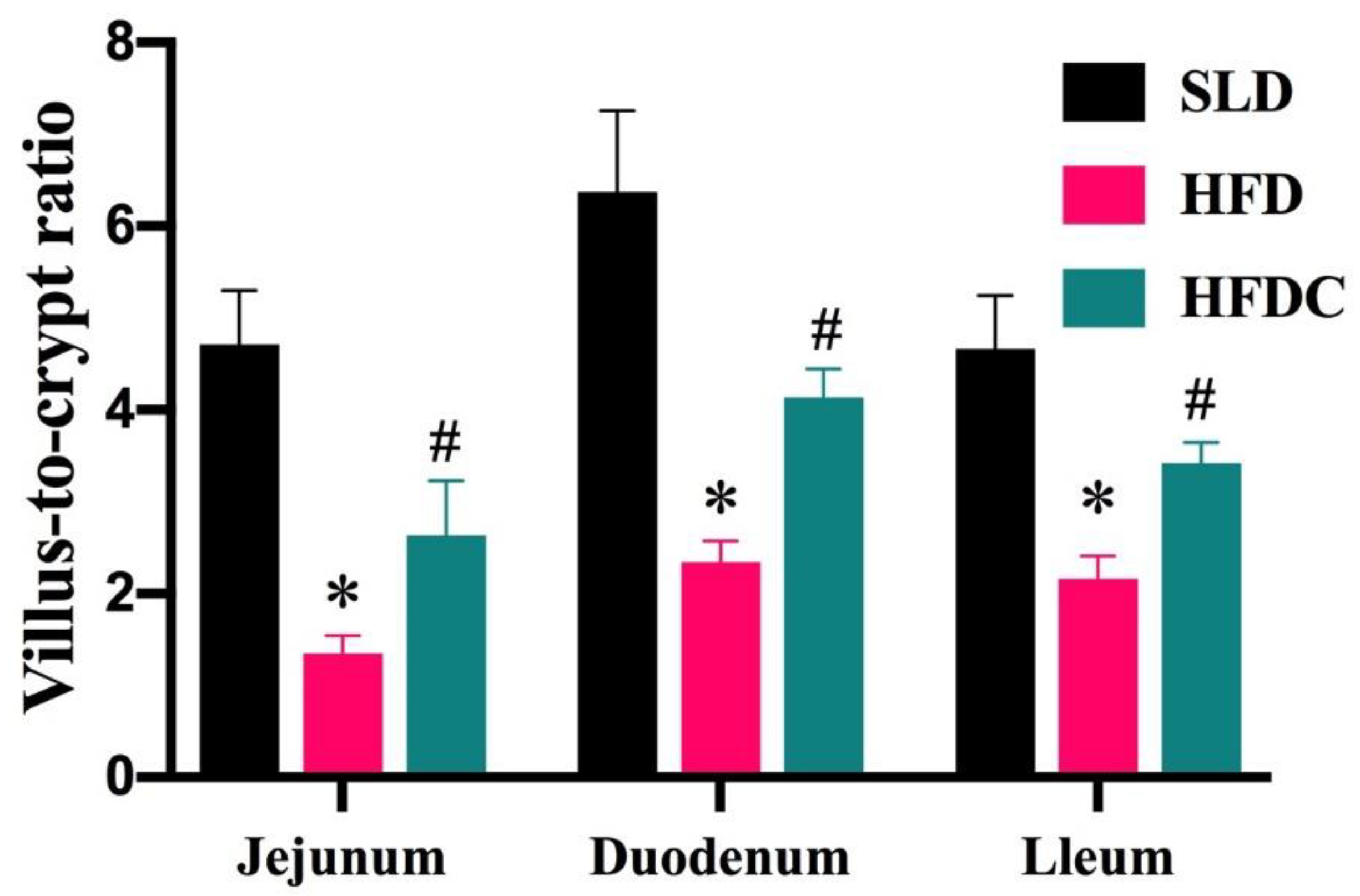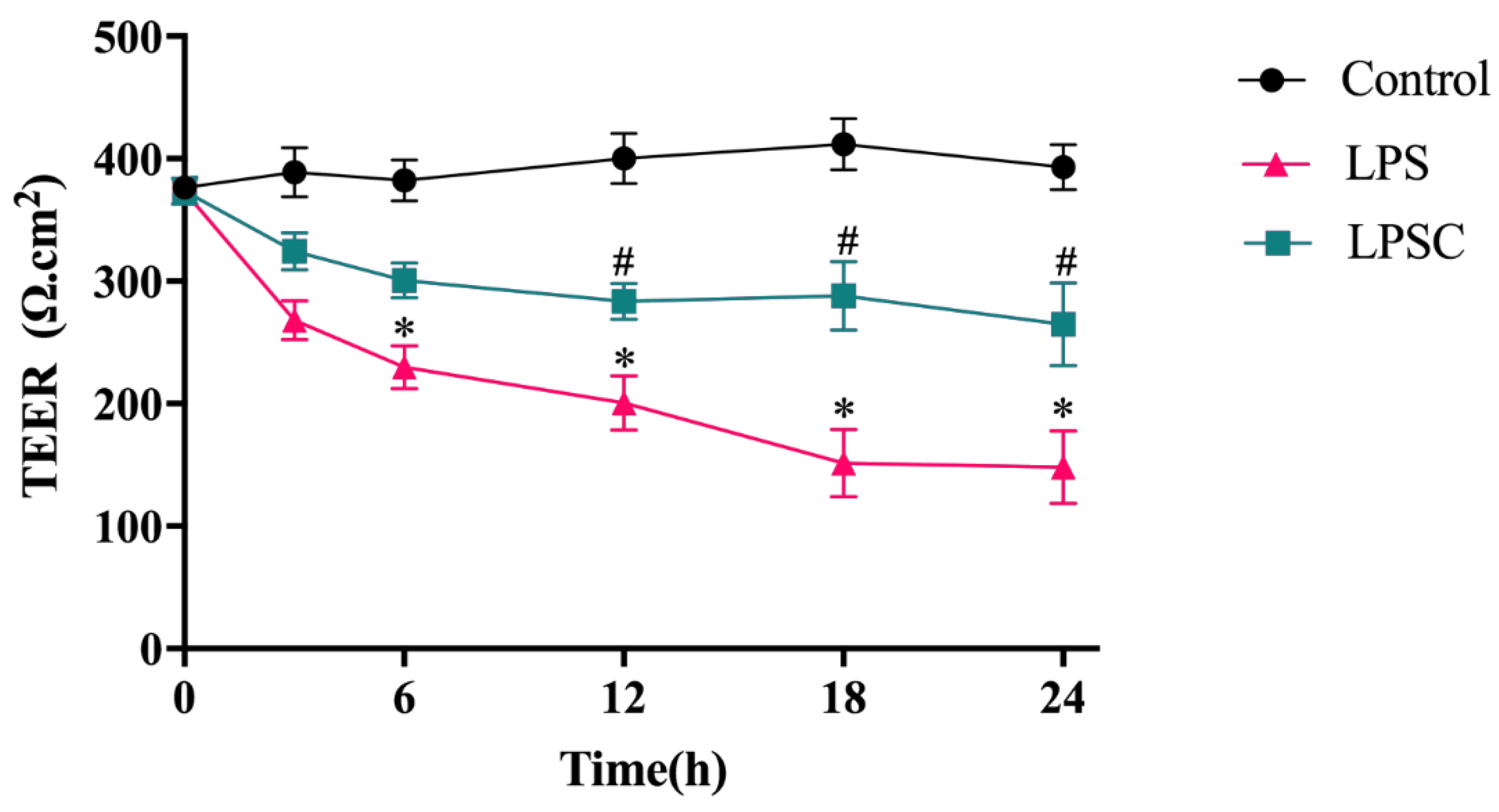Capsaicin Reduces Obesity by Reducing Chronic Low-Grade Inflammation
Abstract
:1. Introduction
2. Results
2.1. Effects of Capsaicin on Body Weight and Food Intake
2.2. Effect of Capsaicin on Serum Biochemical Indices
2.3. Effect of Capsaicin on Oral Glucose Tolerance in Mice
2.4. Effect of Capsaicin on Proteobacteria
2.5. Changes in LPS Levels in the Intestine
2.6. Effect of Capsaicin on Local LPS-Induced Inflammatory Responses
2.7. Effect of Capsaicin on Intestinal Barrier Function
2.8. Effects of Capsaicin on Systemic Endotoxemia and Inflammatory Response
3. Discussion
4. Materials and Methods
4.1. Materials
4.2. Animals and Experimental Design
4.3. Detection of Biochemical Indicators
4.4. Glucose Tolerance Tests
4.5. Quantitative PCR Detection
4.6. Detection of Endotoxin
4.7. Detection of Inflammatory Cytokines
4.8. Histopathological Examination
4.9. Detection of the Relative Expression Level of RNA
4.10. Western Blotting
4.11. Measurement of Trans-Epithelial Electrical Resistance (TEER)
4.12. Statistical Analysis
5. Conclusions
Author Contributions
Funding
Institutional Review Board Statement
Informed Consent Statement
Data Availability Statement
Conflicts of Interest
References
- Unwin, D. Reducing overweight and obesity; so how are we doing? BMJ Nutr. Prev. Health 2024, 7, 1–3. [Google Scholar] [CrossRef] [PubMed]
- Yang, M.; Liu, S.; Zhang, C. The Related Metabolic Diseases and Treatments of Obesity. Healthcare 2022, 10, 1616. [Google Scholar] [CrossRef] [PubMed]
- Gasmi, A.; Noor, S.; Menzel, A.; Dosa, A.; Pivina, L.; Bjorklund, G. Obesity and Insulin Resistance: Associations with Chronic Inflammation, Genetic and Epigenetic Factors. Curr. Med. Chem. 2021, 28, 800–826. [Google Scholar] [CrossRef] [PubMed]
- Zhang, X.; Ha, S.; Lau, H.C.; Yu, J. Excess body weight: Novel insights into its roles in obesity comorbidities. Semin. Cancer Biol. 2023, 92, 16–27. [Google Scholar] [CrossRef] [PubMed]
- Varra, F.N.; Varras, M.; Varra, V.K.; Theodosis-Nobelos, P. Molecular and pathophysiological relationship between obesity and chronic inflammation in the manifestation of metabolic dysfunctions and their inflammation-mediating treatment options. Mol. Med. Rep. 2024, 29, 95. [Google Scholar] [CrossRef] [PubMed]
- Xu, S.; Lu, F.; Gao, J.; Yuan, Y. Inflammation-mediated metabolic regulation in adipose tissue. Obes. Rev. 2024, 25, e13724. [Google Scholar] [CrossRef] [PubMed]
- Miranda, C.S.; Santana-Oliveira, D.A.; Vasques-Monteiro, I.L.; Dantas-Miranda, N.S.; Glauser, J.S.O.; Silva-Veiga, F.M.; Souza-Mello, V. Time-dependent impact of a high-fat diet on the intestinal barrier of male mice. World J. Methodol. 2024, 14, 89723. [Google Scholar] [CrossRef] [PubMed]
- Liu, Y.; Zeng, Y.; Liu, Y.; Wang, X.; Chen, Y.; Lepp, D.; Tsao, R.; Sadakiyo, T.; Zhang, H.; Mine, Y. Regulatory Effect of Isomaltodextrin on a High-Fat Diet Mouse Model with LPS-Induced Low-Grade Chronic Inflammation. J. Agric. Food Chem. 2022, 70, 11258–11273. [Google Scholar] [CrossRef]
- de Lemos, G.M.; Resende, C.M.M.; Campello, C.P.; Ribeiro, I.S.; Mendes, A.K.; de Lima, E.L.S.; de Oliveira, R.M.D.C.; Barbosa Filho, V.C.; Correia, M.J.; Muniz, M.T.C. Is oral microbiota associated with overweight and obesity in children and adolescents? A systematic review. Crit. Rev. Food Sci. Nutr. 2024, 64, 4275–4285. [Google Scholar] [CrossRef]
- Gyriki, D.; Nikolaidis, C.; Stavropoulou, E.; Bezirtzoglou, I.; Tsigalou, C.; Vradelis, S.; Bezirtzoglou, E. Exploring the Gut Microbiome’s Role in Inflammatory Bowel Disease: Insights and Interventions. J. Pers. Med. 2024, 14, 507. [Google Scholar] [CrossRef]
- Wang, Y.; Tang, C.; Tang, Y.; Yin, H.; Liu, X. Capsaicin has an anti-obesity effect through alterations in gut microbiota populations and short-chain fatty acid concentrations. Food Nutr. Res. 2020, 64, 3525. [Google Scholar] [CrossRef] [PubMed]
- Kang, C.; Wang, B.; Kaliannan, K.; Wang, X.; Lang, H.; Hui, S.; Huang, L.; Zhang, Y.; Zhou, M.; Chen, M.; et al. Gut Microbiota Mediates the Protective Effects of Dietary Capsaicin against Chronic Low-Grade Inflammation and Associated Obesity Induced by High-Fat Diet. mBio 2017, 8, e00470-17. [Google Scholar] [CrossRef] [PubMed]
- Wang, G.; Sun, W.; Pei, X.; Jin, Y.; Wang, H.; Tao, W.; Xiao, Z.; Liu, L.; Wang, M. Galactooligosaccharide pretreatment alleviates damage of the intestinal barrier and inflammatory responses in LPS-challenged mice. Food Funct. 2021, 12, 1569–1579. [Google Scholar] [CrossRef]
- Wu, X.X.; Huang, X.L.; Chen, R.R.; Li, T.; Ye, H.J.; Xie, W.; Huang, Z.M.; Cao, G.Z. Paeoniflorin Prevents Intestinal Barrier Disruption and Inhibits Lipopolysaccharide (LPS)-Induced Inflammation in Caco-2 Cell Monolayers. Inflammation 2019, 42, 2215–2225. [Google Scholar] [CrossRef]
- Zhao, L.; Xie, Q.; Etareri Evivie, S.; Liu, D.; Dong, J.; Ping, L.; Liu, F.; Li, B.; Huo, G. Bifidobacterium dentium N8 with potential probiotic characteristics prevents LPS-induced intestinal barrier injury by alleviating the inflammatory response and regulating the tight junction in Caco-2 cell monolayers. Food Funct. 2021, 12, 7171–7184. [Google Scholar] [CrossRef]
- Thornton, T.; Mills, D.; Bliss, E. Capsaicin: A Potential Treatment to Improve Cerebrovascular Function and Cognition in Obesity and Ageing. Nutrients 2023, 15, 1537. [Google Scholar] [CrossRef] [PubMed]
- Zhang, W.; Zhang, Y.; Fan, J.; Feng, Z.; Song, X. Pharmacological activity of capsaicin: Mechanisms and controversies (Review). Mol. Med. Rep. 2024, 29, 38. [Google Scholar] [CrossRef]
- Li, R.; Lan, Y.; Chen, C.; Cao, Y.; Huang, Q.; Ho, C.T.; Lu, M. Anti-obesity effects of capsaicin and the underlying mechanisms: A review. Food Funct. 2020, 11, 7356–7370. [Google Scholar] [CrossRef] [PubMed]
- Lu, Y.C.; Yeh, W.C.; Ohashi, P.S. LPS/TLR4 signal transduction pathway. Cytokine 2008, 42, 145–151. [Google Scholar] [CrossRef]
- Li, X.; Gui, R.; Wang, X.; Ning, E.; Zhang, L.; Fan, Y.; Chen, L.; Yu, L.; Zhu, J.; Li, Z.; et al. Oligosaccharides isolated from Rehmannia glutinosa protect LPS-induced intestinal inflammation and barrier injury in mice. Front. Nutr. 2023, 10, 1139006. [Google Scholar] [CrossRef] [PubMed]
- Jamar, G.; Pisani, L.P. Inflammatory crosstalk between saturated fatty acids and gut microbiota-white adipose tissue axis. Eur. J. Nutr. 2023, 62, 1077–1091. [Google Scholar] [CrossRef] [PubMed]
- Azimirad, M.; Noori, M.; Azimirad, F.; Gholami, F.; Naseri, K.; Yadegar, A.; Asadzadeh Aghdaei, H.; Zali, M.R. Curcumin and capsaicin regulate apoptosis and alleviate intestinal inflammation induced by Clostridioides difficile in vitro. Ann. Clin. Microbiol. Antimicrob. 2022, 21, 41. [Google Scholar] [CrossRef] [PubMed]
- Vasanthkumar, T.; Hanumanthappa, M.; Lakshminarayana, R. Curcumin and capsaicin modulates LPS induced expression of COX-2, IL-6 and TGF-beta in human peripheral blood mononuclear cells. Cytotechnology 2019, 71, 963–976. [Google Scholar] [CrossRef]
- Chen, Y.S.; Lian, Y.Z.; Chen, W.C.; Chang, C.C.; Tinkov, A.A.; Skalny, A.V.; Chao, J.C. Lycium barbarum Polysaccharides and Capsaicin Inhibit Oxidative Stress, Inflammatory Responses, and Pain Signaling in Rats with Dextran Sulfate Sodium-Induced Colitis. Int. J. Mol. Sci. 2022, 23, 2423. [Google Scholar] [CrossRef]
- Zhang, Y.; Zhang, X.Y.; Shi, S.R.; Ma, C.N.; Lin, Y.P.; Song, W.G.; Guo, S.D. Natural products in atherosclerosis therapy by targeting PPARs: A review focusing on lipid metabolism and inflammation. Front. Cardiovasc. Med. 2024, 11, 1372055. [Google Scholar] [CrossRef] [PubMed]
- Toyoda, T.; Shi, L.; Takasu, S.; Cho, Y.M.; Kiriyama, Y.; Nishikawa, A.; Ogawa, K.; Tatematsu, M.; Tsukamoto, T. Anti-Inflammatory Effects of Capsaicin and Piperine on Helicobacter pylori-Induced Chronic Gastritis in Mongolian Gerbils. Helicobacter 2016, 21, 131–142. [Google Scholar] [CrossRef] [PubMed]
- Andrei, C.; Zanfirescu, A.; Nițulescu, G.M.; Olaru, O.T.; Negreș, S. Natural Active Ingredients and TRPV1 Modulation: Focus on Key Chemical Moieties Involved in Ligand-Target Interaction. Plants 2023, 12, 339. [Google Scholar] [CrossRef] [PubMed]
- Güzel, M.; Akpınar, O. Hydroxychloroquine Attenuates Acute Inflammation (LPS)-Induced Apoptosis via Inhibiting TRPV1 Channel/ROS Signaling Pathways in Human Monocytes. Biology 2021, 10, 967. [Google Scholar] [CrossRef]
- Vašek, D.; Fikarová, N.; Marková, V.N.; Honc, O.; Pacáková, L.; Porubská, B.; Somova, V.; Novotný, J.; Melkes, B.; Krulová, M. Lipopolysaccharide pretreatment increases the sensitivity of the TRPV1 channel and promotes an anti-inflammatory phenotype of capsaicin-activated macrophages. J. Inflamm. 2024, 21, 17. [Google Scholar] [CrossRef] [PubMed]
- Zhong, B.; Ma, S.; Wang, D.H. Ablation of TRPV1 Elevates Nocturnal Blood Pressure in Western Diet-fed Mice. Curr. Hypertens. Rev. 2019, 15, 144–153. [Google Scholar] [CrossRef]
- Kuo, W.T.; Odenwald, M.A.; Turner, J.R.; Zuo, L. Tight junction proteins occludin and ZO-1 as regulators of epithelial proliferation and survival. Ann. N. Y. Acad. Sci. 2022, 1514, 21–33. [Google Scholar] [CrossRef] [PubMed]
- Moonwiriyakit, A.; Pathomthongtaweechai, N.; Steinhagen, P.R.; Chantawichitwong, P.; Satianrapapong, W.; Pongkorpsakol, P. Tight junctions: From molecules to gastrointestinal diseases. Tissue Barriers 2023, 11, 2077620. [Google Scholar] [CrossRef]
- Dunleavy, K.A.; Raffals, L.E.; Camilleri, M. Intestinal Barrier Dysfunction in Inflammatory Bowel Disease: Underpinning Pathogenesis and Therapeutics. Dig. Dis. Sci. 2023, 68, 4306–4320. [Google Scholar] [CrossRef] [PubMed]
- Fang, X.; Nong, K.; Wang, Z.; Jin, Y.; Gao, F.; Zeng, Q.; Wang, X.; Zhang, H. Human cathelicidin LL-37 exerts amelioration effects against EHEC O157:H7 infection regarding inflammation, enteric dysbacteriosis, and impairment of gut barrier function. Peptides 2023, 159, 170903. [Google Scholar] [CrossRef]
- He, K.Y.; Lei, X.Y.; Wu, D.H.; Zhang, L.; Li, J.Q.; Li, Q.T.; Yin, W.T.; Zhao, Z.L.; Liu, H.; Xiang, X.Y.; et al. Akkermansia muciniphila protects the intestine from irradiation-induced injury by secretion of propionic acid. Gut Microbes 2023, 15, 2293312. [Google Scholar] [CrossRef] [PubMed]
- Jian, Y.; Zhang, D.; Liu, M.; Wang, Y.; Xu, Z.X. The Impact of Gut Microbiota on Radiation-Induced Enteritis. Front. Cell Infect. Microbiol. 2021, 11, 586392. [Google Scholar] [CrossRef] [PubMed]
- Santos, E.A.; Silva, J.L.; Leocádio, P.C.L.; Andrade, M.E.R.; Queiroz-Junior, C.M.; Oliveira, N.S.S.; Alves, J.L.; Oliveira, J.S.; Aguilar, E.C.; Boujour, K.; et al. Cutaneous Application of Capsaicin Cream Reduces Clinical Signs of Experimental Colitis and Repairs Intestinal Barrier Integrity by Modulating the Gut Microbiota and Tight Junction Proteins. ACS Pharmacol. Transl. Sci. 2024, 7, 2143–2153. [Google Scholar] [CrossRef] [PubMed]
- Nazari, H.; Shrestha, J.; Naei, V.Y.; Bazaz, S.R.; Sabbagh, M.; Thiery, J.P.; Warkiani, M.E. Advances in TEER measurements of biological barriers in microphysiological systems. Biosens. Bioelectron. 2023, 234, 115355. [Google Scholar] [CrossRef] [PubMed]
- Jang, S.Y.; Kim, S.Y.; Song, H.A.; Kim, H.; Chung, K.S.; Lee, J.K.; Lee, K.T. Protective effect of hydrangenol on lipopolysaccharide-induced endotoxemia by suppressing intestinal inflammation. Int. Immunopharmacol. 2023, 125, 111083. [Google Scholar] [CrossRef]
- Guo, S.; Zhao, H.; Ma, Z.; Zhang, S.; Li, M.; Zheng, Z.; Ren, X.; Ho, C.T.; Bai, N. Anti-Obesity and Gut Microbiota Modulation Effect of Secoiridoid-Enriched Extract from Fraxinus mandshurica Seeds on High-Fat Diet-Fed Mice. Molecules 2020, 25, 4001. [Google Scholar] [CrossRef]
- Li, Y.; Liu, Q.; Peng, C.; Ruan, B. Both Gut Microbiota and Differentially Expressed Proteins Are Relevant to the Development of Obesity. Biomed. Res. Int. 2020, 2020, 5376108. [Google Scholar] [CrossRef] [PubMed]
- Wei, G.; Ye, Y.; Yan, X.; Chao, X.; Yang, F.; Wang, M.; Zhang, W.; Yuan, C.; Zeng, Q. Effect of banana pulp dietary fibers on metabolic syndrome and gut microbiota diversity in high-fat diet mice. J. Food Biochem. 2020, 44, e13362. [Google Scholar] [CrossRef] [PubMed]
- Li, J.; Lv, J.L.; Cao, X.Y.; Zhang, H.P.; Tan, Y.J.; Chu, T.; Zhao, L.L.; Liu, Z.; Ren, Y.S. Gut microbiota dysbiosis as an inflammaging condition that regulates obesity-related retinopathy and nephropathy. Front. Microbiol. 2022, 13, 1040846. [Google Scholar] [CrossRef] [PubMed]
- Cao, Y.; Zou, L.; Li, W.; Song, Y.; Zhao, G.; Hu, Y. Dietary quinoa (Chenopodium quinoa Willd.) polysaccharides ameliorate high-fat diet-induced hyperlipidemia and modulate gut microbiota. Int. J. Biol. Macromol. 2020, 163, 55–65. [Google Scholar] [CrossRef] [PubMed]
- Di Vincenzo, F.; Del Gaudio, A.; Petito, V.; Lopetuso, L.R.; Scaldaferri, F. Gut microbiota, intestinal permeability, and systemic inflammation: A narrative review. Intern. Emerg. Med. 2024, 19, 275–293. [Google Scholar] [CrossRef] [PubMed]
- Wang, Y.; Liu, X. Construction of TRPV1 gene knockout Caco -2 stable cell line based on CRISPR/Cas9 technology. J. Southwest Minzu Univ. 2020, 46, 241–249. [Google Scholar]
- Benejat, L.; Ducournau, A.; Lehours, P.; Megraud, F. Real-time PCR for Helicobacter pylori diagnosis. The best tools available. Helicobacter 2018, 23, e12512. [Google Scholar] [CrossRef] [PubMed]
- Fite, A.; Macfarlane, G.T.; Cummings, J.H.; Hopkins, M.J.; Kong, S.C.; Furrie, E.; Macfarlane, S. Identification and quantitation of mucosal and faecal desulfovibrios using real time polymerase chain reaction. Gut 2004, 53, 523–529. [Google Scholar] [CrossRef]
- Williams, B.L.; Hornig, M.; Parekh, T.; Lipkin, W.I. Application of novel PCR-based methods for detection, quantitation, and phylogenetic characterization of Sutterella species in intestinal biopsy samples from children with autism and gastrointestinal disturbances. mBio 2012, 3, e00261-11. [Google Scholar] [CrossRef]
- Tu, J.; Xu, Y.; Xu, J.; Ling, Y.; Cai, Y. Chitosan nanoparticles reduce LPS-induced inflammatory reaction via inhibition of NF-kappaB pathway in Caco-2 cells. Int. J. Biol. Macromol. 2016, 86, 848–856. [Google Scholar] [CrossRef]
- Li, X.F.; Zhang, X.J.; Zhang, C.; Wang, L.N.; Li, Y.R.; Zhang, Y.; He, T.T.; Zhu, X.Y.; Cui, L.L.; Gao, B.L. Ulinastatin protects brain against cerebral ischemia/reperfusion injury through inhibiting MMP-9 and alleviating loss of ZO-1 and occludin proteins in mice. Exp. Neurol. 2018, 302, 68–74. [Google Scholar] [CrossRef] [PubMed]
- Kalantari, N.; Ghasemi, M.; Bayani, M.; Ghaffari, S. Effect of honey on mRNA expression of TNF-alpha, IL-1beta and IL-6 following acute toxoplasmosis in mice. Cytokine 2016, 88, 85–90. [Google Scholar] [CrossRef] [PubMed]












| Parameter | SLD | HFD | HFDC |
|---|---|---|---|
| Initial Body Weight (g) | 22.12 ± 0.95 | 21.90 ± 0.74 | 22.27 ± 1.06 |
| Final Body Weight (g) | 31.04 ± 0.96 | 41.06 ± 1.16 * | 35.70 ± 1.65 # |
| Body Weight Gain(g) | 8.92 ± 0.67 | 19.16 ± 0.63 * | 13.43 ± 1.52 # |
| Average Feed Intake (g/d) | 3.27 ± 0.13 | 5.16 ± 0.11 * | 4.09 ± 0.13 # |
| Total Feed Intake (g) | 274.47 ± 11.34 | 433.16 ± 9.40 * | 343.42 ± 10.80 # |
| Bacterial Species | Primer | Sequence(5′-3′) | References |
|---|---|---|---|
| Helicobater | Forward | GCTCTCACTTCCATAGGCTATAATGTG | [47] |
| Reverse | GCGCATGTCTTCGGTTAAAAA | ||
| Probe | FAM-TAGGGCCTATGCCTACCCCTGCGA-TAMARA | ||
| Desulfovibrio | Forward | CCGTAGATATCTGGAGGAACATCAG | [48] |
| Reverse | ACATCTAGCATCCATCGTTTACAGC | ||
| Sutterella | Forward | CGCGAAAAACCTTACCTAGCC | [49] |
| Reverse | GACGTGTGAGGCCCTAGCC | ||
| Probe | FAM-CACAGGTGCTGCATGGCTGTCGT-NFQ |
| Gene | Primer | Sequence(5′-3′) | References |
|---|---|---|---|
| ZO-1(human) | Forward | GGTGAAGTGAAGACAATG | [14] |
| Reverse | GGTAATATGGTGAAGTTAGAG | ||
| Occludin(human) | Forward | GAGTTGTATCTGTTGTTGT | |
| Reverse | TTCGTGGTATAGCATTCT | ||
| IL-6(human) | Forward | GACAGCCACTCACCTCTTCA | |
| Reverse | TTCACCAGGCAAGTCTCCTC | ||
| TNF-α(human) | Forward | GTCAGATCATCTTCTCGA ACC | |
| Reverse | CAGATAGATGGGCTCATACC | ||
| TLR 4(human) | Forward | CTGGAAATATGACCACAGTCAGAA | [50] |
| Reverse | TCAATCA CCCTAGACCTGCTCAA | ||
| GAPDH(human) | Forward | CTGACTTCAACAGCGACACC | |
| Reverse | AGCCAAATTCGTTGTCATACC | ||
| Occludin(mice) | Forward | CCTTCTGCTTCATCGCTTCCTTA | [51] |
| Reverse | CGTCGGGTTCACTCCCATTAT | ||
| ZO-1(mice) | Forward | GATAGTTTGGCAGCAAGAGATGGTA | |
| Reverse | AGGTCAGGGACGTTCAGTAAGGTAG | ||
| IL-6(mice) | Forward | CACATGTTCTCTGGGAAATCG | [52] |
| Reverse | TTGTATCTCTGGAAGTTTCAGATTGTT | ||
| TNF-α(mice) | Forward | GCCACCACGCTCTTCTGTCTAC | |
| Reverse | GGGTCTGGGCCATAGAACTGAT | ||
| TLR 4(mice) | Forward | CGCTTTCACCTCTGCCTTCACTACAG | [12] |
| Reverse | ACACTACCACAATAACCTTCCGGCTC | ||
| GAPDH(mice) | Forward | GCATCCACTGGTGCTGCC | |
| Reverse | TCATCATACTTGGCAGGTTTC |
Disclaimer/Publisher’s Note: The statements, opinions and data contained in all publications are solely those of the individual author(s) and contributor(s) and not of MDPI and/or the editor(s). MDPI and/or the editor(s) disclaim responsibility for any injury to people or property resulting from any ideas, methods, instructions or products referred to in the content. |
© 2024 by the authors. Licensee MDPI, Basel, Switzerland. This article is an open access article distributed under the terms and conditions of the Creative Commons Attribution (CC BY) license (https://creativecommons.org/licenses/by/4.0/).
Share and Cite
Yang, J.; Li, W.; Wang, Y. Capsaicin Reduces Obesity by Reducing Chronic Low-Grade Inflammation. Int. J. Mol. Sci. 2024, 25, 8979. https://doi.org/10.3390/ijms25168979
Yang J, Li W, Wang Y. Capsaicin Reduces Obesity by Reducing Chronic Low-Grade Inflammation. International Journal of Molecular Sciences. 2024; 25(16):8979. https://doi.org/10.3390/ijms25168979
Chicago/Turabian StyleYang, Jiaxin, Wanyi Li, and Yuanwei Wang. 2024. "Capsaicin Reduces Obesity by Reducing Chronic Low-Grade Inflammation" International Journal of Molecular Sciences 25, no. 16: 8979. https://doi.org/10.3390/ijms25168979





